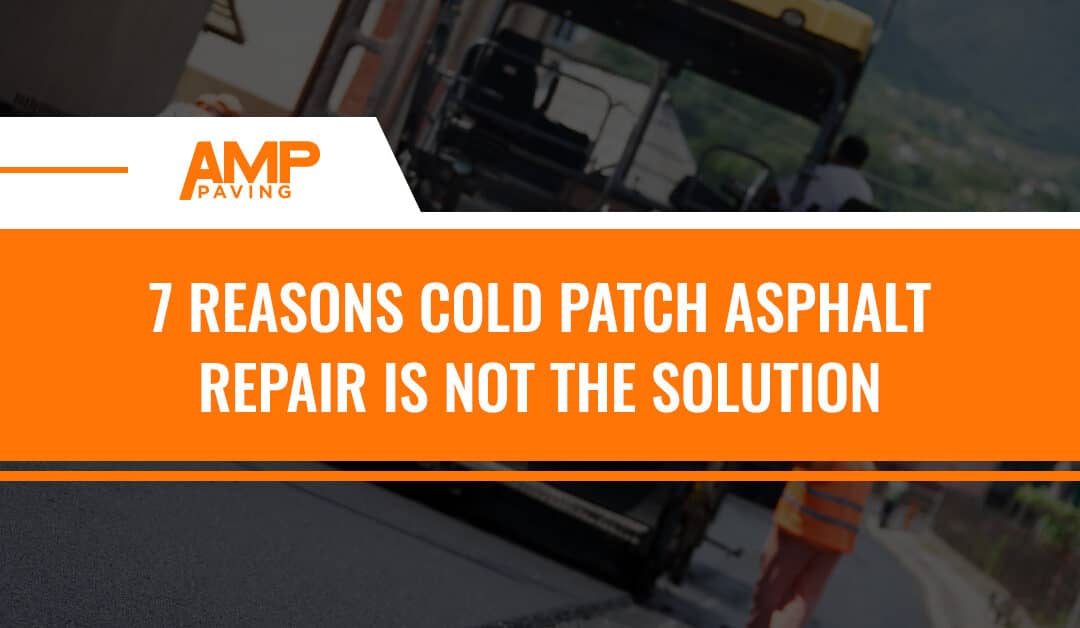Maintaining asphalt surfaces is essential to owning a home or managing property. When damage occurs, prompt repairs prevent further deterioration. However, choosing the right repair solution is crucial to ensure the repair is long-lasting and cost-effective. You may be one of many who assume they can apply a cold patch asphalt repair for a quick and easy solution. However, hot-mix asphalt (HMA) is always the better choice for durability and longevity.
In this blog post, we will discuss seven reasons why cold patch asphalt repair is never the ideal solution. We’ll also see why hot mix asphalt is the preferred option for asphalt repair.
Cold Asphalt Patch Repair Fails In 7 Significant Ways
Cold mix asphalt products may promise a ready-to-use mixing solution to fill your cracks and potholes. However, you need additional information before taking action the cheap and “easy” way.
Read on to discover the seven reasons cold mix products fail every time and in every way.
1. Durability
Cold patch asphalt is not as durable as hot mix asphalt and may not last as long. Asphalt paving companies strive to provide their customers with long-lasting, cost-effective solutions for the long run. Cold patch asphalt simply does not meet these criteria.
Cold patch asphalt is designed for a quick temporary fix. It consists of small aggregate, binder, and water. This material has a high percentage of voids or areas not well-compacted. The voids make it susceptible to water intrusion, freeze-thaw cycles, and UV rays. These factors all contribute to deterioration over time.
Additionally, cold patch asphalt is not engineered to withstand heavy traffic loads. Heavy trucks or machinery can cause the repair to disintegrate and become unstable. As a result, cold mix cannot provide the same level of long-term durability as hot mix asphalt.
Manufacturers specifically engineer HMA to be strong, water-resistant, and adequately handle heavy traffic loads.
2. Appearance
Cold patch asphalt may not match the existing pavement’s color or texture, which could make it stand out and look unappealing. Asphalt paving companies take pride in providing seamless repairs that blend in with the surrounding pavement and improve the area’s overall appearance.
Cold patch asphalt does not blend well with the existing pavement, making the repair visible and unappealing. Since cold patch asphalt does not bond well with the surrounding pavement, it tends to have a rough texture that makes it stand out even more.
Conversely, hot mix asphalt is specifically engineered to blend seamlessly with the surrounding pavement. HMA ensures a more smooth and uniform appearance, making it more aesthetically pleasing.
3. Water Resistance
Cold patch asphalt is less water-resistant than hot mix asphalt. Water is a significant factor in the deterioration of asphalt. HMA provides better water resistance and overall durability.
Cold patch asphalt is not designed to have a strong bond with the surrounding pavement. It can break down and separate when exposed to moisture. As a result, water can seep into the repair and create voids, further damaging the pavement.
Additionally, cold patch asphalt does not have the same flexibility as hot mix asphalt, which can cause it to crack and break apart when exposed to freeze-thaw cycles or other environmental factors.
On the other hand, hot mix asphalt is specifically designed to resist water penetration and provide long-term durability.
4. Stability Against Weather Conditions
Cold patch asphalt is less stable than hot mix asphalt, causing it to shift or settle over time. Cold patch asphalt is typically applied by hand, which can result in uneven compaction and inconsistent thickness. This can create weak spots in the repair, which can cause it to break apart under heavy traffic loads.
In contrast, HMA is installed using specialized equipment that can achieve a consistent thickness and proper compaction. HMA ensures a strong and stable repair that can withstand heavy traffic loads.
5. NO Compaction With Roller
Cold patch asphalt is harder to compact correctly, which can leave voids or air pockets in the repair.
Cold patch asphalt is typically applied by hand and compacted by the weight of vehicles or a hand tamper. Compacting asphalt in this way may result in uneven compaction and a lower density. The lack of compaction can create weak spots in the repair, leading to further damage over time.
In contrast, HMA is installed using specialized equipment, such as a drum roller and pavers, which can achieve proper compaction and a higher density. The higher density of an HMA product ensures the pavement is solid and durable.
As a result, cold patch asphalt cannot match the same level of compaction and density as an HMA product installed by a professional contractor.
6. Base Assessment Failings
When repairing asphalt, it is essential to check the base underneath the previous asphalt to ensure that it is stable and can support the new pavement. Hot mix asphalt allows professional contractors to assess the base more accurately and make necessary repairs or adjustments.
HMA is typically installed in multiple layers, with each layer providing a specific function in the pavement structure. The bottom layer, known as the sub-base, provides the foundational support for the pavement. The top layer, known as the surface course, provides wear resistance and skid resistance.
In order to achieve a durable and long-lasting pavement, it is vital to assess the condition of the base and make any necessary repairs or adjustments before installing the HMA layers.
Professional contractors use specialized equipment, such as saws and milling machines, to cut out and remove damaged or weakened areas in the base. They then compact and level the base to ensure adequate support for the HMA layers.
7. Time is NOT On Your Side
Cold patch asphalt may seem like a quick fix, but it may not last as long, leading to more frequent repairs in the future. Factors that lead to problems over time include:
- Lack of proper compaction
- Weak bond with surrounding pavement
- Poor water resistance
- Can’t withstand heavy traffic loads or environmental factors such as freeze-thaw cycles, which can cause it to break apart and further deteriorate.
Asphalt paving contractors prefer to use a hot mix asphalt product, which may take more time to install initially. However, it provides a longer-lasting solution, ultimately saving time and money in the long run.
Asphalt Cold Patch is Not a Repair Solution
If you’re looking for a high-performance solution and permanent repairs, a cold mix product is not the solution it’s marketed to be. It may come in a 50 lb bag with promises of ready and easy application. However, buyer beware.
Asphalt contractors know that HMA is engineered to provide maximum load-bearing capacity and resistance to environmental factors. These hot mix repairs remain stable and durable for many years. The use of specialized equipment, proper base preparation, and a high-quality mix design all contribute to the longevity of HMA.
Overall, cold patch asphalt repair cannot match the durability and longevity of HMA installed by a professional contractor.
Proper Asphalt Repair Process
An experienced asphalt contractor will go through several specific steps to make a proper repair to your asphalt, including the following:
- Make a thorough evaluation of the existing pavement to determine the cause of the damage in the first place.
- Use specialized equipment such as infrared heaters or milling machines to remove the damaged areas.
- Assess and ensure the base is stable.
- Determine the appropriate mix design, thickness, and installation method for the new asphalt layers.
- Carefully engineer the mix design to provide adequate load-bearing capacity for your project and resistance to specific environmental factors.
- Determine the thickness of the asphalt layers based on the anticipated traffic loads and the existing base condition.
- Carefully plan the installation method to ensure proper compaction and achieve the desired density.
Your pavement may have many problems, including:
- Cracks
- Pothole problems
- Old patch issues
However, your pavement issues will not go away with cold patch repairs. For a real repair job, contact your local asphalt contractor. A professional asphalt contractor can engineer durable and long-lasting solutions for extensive asphalt repairs.
Let Our Experienced Asphalt Contractors Handle Your Repairs
At AMP Paving, we recognize that asphalt repairs can represent a significant investment. We understand how to engineer proper repairs for your asphalt surface to eliminate your risk of further damage.
Whether your property is a large commercial lot or a small residential driveway, we possess the expertise and equipment to complete your project promptly and within your budget.
Get in touch for your free estimate today!

